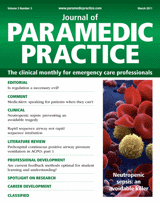On Combat: The Psychology and Physiology of Deadly Conflict in War and in Peace
Written by a retired US army colonel with a PhD in psychology, On Combat describes the psychological and physiological effects combat has on the human condition. Although aimed at those facing physical violence and conflict—namely soldiers and law enforcement officers—there are uncanny comparisons to be made with pre-hospital critical care. By replacing ‘combat’ with ‘resuscitation’, certain sections speak clearly to the paramedic profession.
One of the most relevant sections was on fear, physiological arousal and performance. Four conditions are used to describe the various changes in performance factors under increasing levels of stress: white (stress free) to yellow (vigilant), red (optimal survival) and finally black (overload). At a heart rate of around 115 bpm, fine motor skills begin to deteriorate. Conditions red and black bring about a reduction in complex motor skills, cognitive functioning, and auditory and visual senses. This is also applicable to the states we find patients involved in stressful events such as traffic collisions or violence. The associated increases in vital signs are well documented, but their inability to recall events is not so widely known.
Subscribe to get full access to the Journal of Paramedic Practice
Thank you for visiting the Journal of Paramedic Practice and reading our archive of expert clinical content. If you would like to read more from the only journal dedicated to those working in emergency care, you can start your subscription today for just £48.
What's included
-
CPD Focus
-
Develop your career
-
Stay informed

